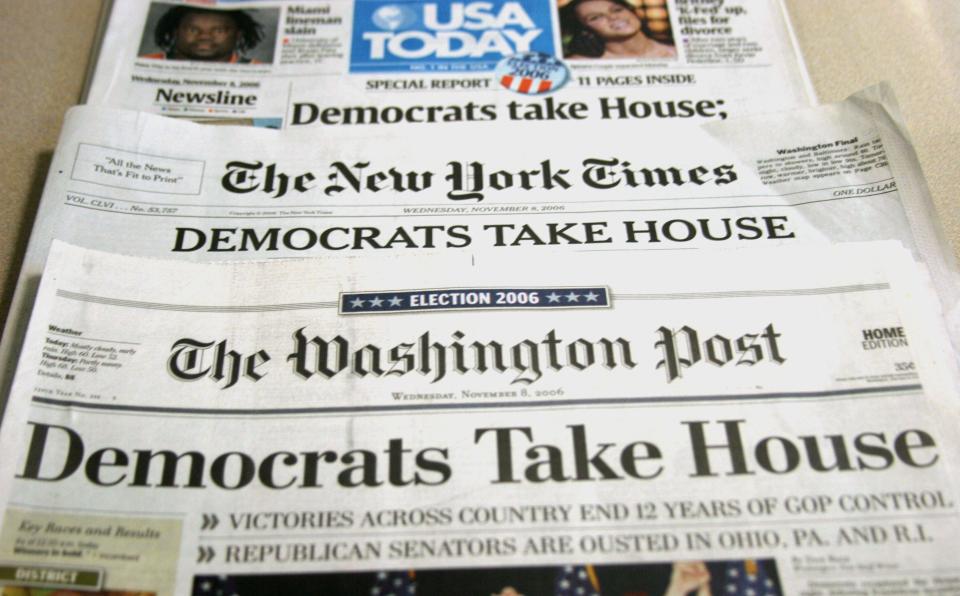Democrats Look To Their Successful 2006 Messaging In Bid To Retake The House

WASHINGTON ― Democrats are looking back to the last time they took control of the House for lessons on what may work this year, and they’re starting to narrow in on a major theme: the Republican “culture of corruption, cronyism and incompetence.”
In 2006, Democrats won majorities in both the House and Senate, breaking the hold Republicans had on Congress for more than a decade.
“In Iraq and here at home, Americans have made clear they are tired of the failures of the last six years,” Sen. Harry Reid of Nevada (D-Nev.), who became the majority leader in the new Congress, said at the time.
There’s no doubt that deep dissatisfaction with then-President George W. Bush ― from his handling of Hurricane Katrina to the Iraq War ― created a tough atmosphere for Republicans. Getting out of Iraq, in particular, was a rallying cry for a growing progressive base that mobilized and organized in a way that’s similar to what has happened with the resistance movement on the left in the wake of President Donald Trump’s win.
But in the House, a number of scandals besieged Republicans.
“Choking your mistress. Touching little boys. Taking money from the Russians. Questionable business dealings. You name it, we had it. On and on, never ended,” said a GOP strategist who worked at the National Republican Congressional Committee in 2006 and requested anonymity to speak openly.
Democrats seized on these issues and created a “culture of corruption” refrain that another former NRCC operative said was extremely effective. In many ways, it pulled from what former Georgia Rep. Newt Gingrich (R) did in the 1980s, when he portrayed Congress as a corrupt institution and hammered various internal scandals. It led to the downfall of the Democratic speaker, Jim Wright, and eventually installed a Republican majority in the House with Gingrich as the new guy in charge.
In 2006, the scandals dripped out bit by bit. Republicans watched them pile up, but still thought they might be able to keep the House ― until September when the Mark Foley scandal broke. The news that the GOP congressman from Florida had been sending sexually explicit text messages to teenage boys was the final nail in the coffin.
“Literally overnight, everybody’s polling data went down 20 points. I’ve never seen anything like it since,” said one of the former NRCC aides.
House Minority Leader Nancy Pelosi (D-Calif.) is bringing back her 2006 refrain for this cycle. It first appeared in an April 6 statement calling for the resignation of Environmental Protection Agency head Scott Pruitt, saying he was “a part of the Trump Administration’s culture of corruption, cronyism and incompetence.”
It then popped up later that day in one of her press releases, and then three days later in a letter to her colleagues about their priorities in the coming months.
In her weekly press conference the following day, she used the phrase twice, reminding reporters of that earlier election: “Some may recall that in 2005, 2006, one of our mantras during the campaign was to drain the swamp, to end the Republican culture of cronyism, corruption and incompetence, and that is exactly what we did. The president has misappropriated that term of art, ‘drain the swamp,’ and what does he do but have an administration that is wallowing in it.”
Other Democrats say that the message has been talked about in strategy meetings as something they want to do more of.
The targets in Congress aren’t as obvious as they were last time, with many of the men who were caught up in recent sexual harassment scandals quickly resigning on their own. But there’s plenty of material for them to work with in the Trump administration, including abuses that the Republican leadership in Congress has been unwilling to speak up against. Also expect Democrats to go after Republicans for how they, or their corporate donors, benefitted from the tax cut law.

Of course, many of the Democrats’ gains were short-lived. In 2010, the next midterm cycle, Republicans swept back into office in dramatic fashion, buoyed by the momentum of the tea party. They retook the House and picked up seats in the Senate.
In particular, the 2010 elections all but wiped out many of the more conservative Democrats who won in redder districts.
“It was a great short-term strategy,” one of the former NRCC aides said. “It allowed them to pass Obamacare. But the joke was up four years later.”
With Democrats competitive in more seats than usual this year, there’s concern that they could see their gains wiped out in cycles where the progressive base is less energized.
But Anna Greenberg, a Democratic pollster at Greenberg Quinlan Rosner Research, notes that the expanded map this year is different than it was in 2006. Democrats then won a bunch of seats “that they had no business winning” because they were such long shots ― Republican districts that Sen. John McCain (R-Ariz.) had won in the presidential race in 2008.
This year, however, Democrats are trying to pick up seats in districts that Hillary Clinton won in 2016. Take Texas’ 7th Congressional District, for example. Republican Mitt Romney won it by 21 points in 2012, but Clinton then won it by two points last year.
“Massive shifts in these districts,” Greenberg said. “I think those changes are enduring because this is built on an actual trend that is happening around college-educated voters becoming more Democratic, and they’re much more likely to live in these suburban areas. I don’t necessarily see a radical swing back to the norm like we did in 2010.”
Karin Johanson, the executive director of the Democratic Congressional Campaign Committee in the 2006 cycle, and she said she had no idea this far out that they had a chance to retake the House.
“The most anybody saw was that we were going to pick up some seats,” she said. “By March, we still didn’t know we could take the House back. It always seemed really really hard, the number of seats we’d need.”

There also wasn’t the same grassroots energy that is present this time, Johanson said. Groups like MoveOn, Americans Against Escalation In Iraq and VoteVets mobilized people around the war and helped turn the tide of public opinion toward withdrawal. That movement sparked a generation of activists who are still in politics today. But online organizing was still relatively new and while effective, didn’t happen on the scale of 2018. Democratic candidates have said they’ve never seen anything like what’s happening in the resistance now.
“There is no one single figurehead to take on the president, and that gives us an opportunity for new leadership to arise naturally from the grassroots standpoint,” said Jon Soltz, the co-founder of VoteVets. “That’s the sort of momentum you’re seeing.”
But this time, Republicans have more warning signs, which is helping them prepare. Scott Walker, the Republican governor of Wisconsin, has urged his party to take all the recent Democratic wins in special elections seriously ― otherwise the party will be drowned in a blue wave in November.
Love HuffPost? Become a founding member of HuffPost Plus today.
This article originally appeared on HuffPost.

